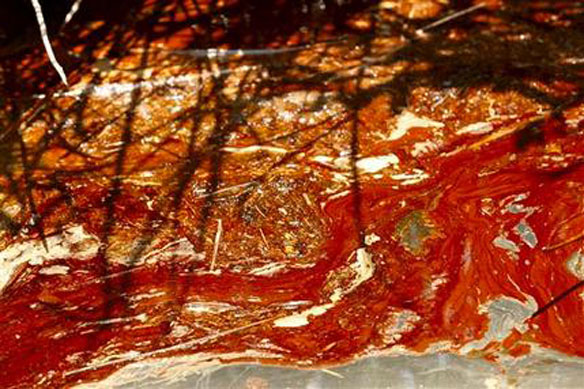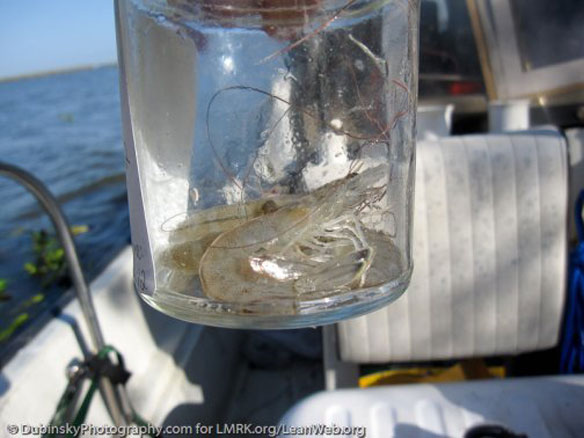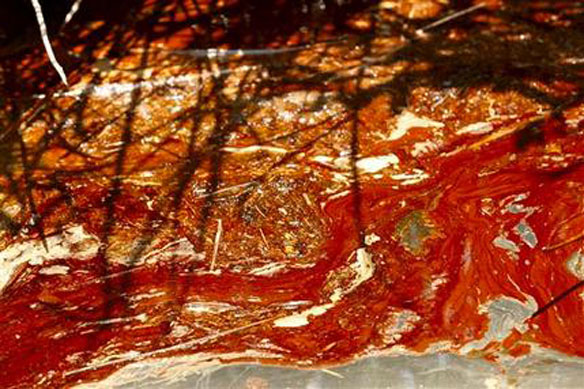
BP Oil Spill. Oil Pollution Reaches Marshes. Photo Source: Gerald Herbert
Evaluation of the Results of Whole Blood Volatile Solvents Testing
By Wilma Subra, Subra Company, for the Louisiana Environmental Action Network
Samples of blood were collected on December 16, 2010, from four males, age 3, 36, 42 and 43, and one female, age 38. The individuals tested were a diver who came in contact with the BP spill chemicals, individuals who visited the coastal communities and wetlands, documenting the impacts of the BP spill, and individuals exposed along the beaches.
The whole blood samples were analyzed for Volatile Solvents by Method 0762, Gas Chromatography/Mass Spectrometry, by Metametrix Clinical Laboratory in Duluth, Georgia
Ethylbenzene
Ethylbenzene was detected in all five blood samples in excess of the NHANES 95th Percentile value. The male diver had the highest concentration of Ethylbenzene, 0.63 ppb, which was 5.7 times the 95th Percentile NHANES value. The male diver also had the highest value of Ethylbenzene when compared to the other 9 individuals whose blood had been previously tested (1.3 times the highest previous value). The previous samplings of blood for volatile solvents were performed on residents exposed along the coast and BP cleanup workers.
The second highest concentration of Ethylbenzene was 3.3 times the 95th Percentile and occurred in the 3 year old male. The third highest concentration of Ethylbenzene was 2.8 times the 95th Percentile and occurred in the 38 year old female.
m,p-Xylene
m,p-Xylene was detected in four of the five blood samples in excess of the NHANES 95th Percentile value. The male diver had the highest concentration of m,p-Xylene, 1.93 ppb, which was 5.68 times the 95th Percentile NHANES value. The male diver also had the highest value of m,p-Xylene when compared to the other 9 individuals whose blood had been previously tested (1.5 times the highest previous value). The 36 year old male did not have detectable levels of m,p-Xylene.
Hexane
Hexane was detected in all five blood samples. The highest concentration of Hexane in the blood occurred in the 3 year old male and the 36 year old male.. The hexane concentrations in the blood of the 3 year old male and 36 year old male were in the 40th Percentile. The Hexane values detected in the five blood samples fell in the same range as the previous 9 blood samples.
2-Methylpentane
The concentrations of 2-Methylpentane were highest in the 3 year old male and 36 year old male. The 2-Methylpentane values in the 3 year old male and 36 year old male were elevated and in the 82nd Percentile. The 2-Methylpentane values were in the same range as the previous nine blood samples analyzed.
3-Methylpentane
The concentrations of 3-Methylpentane were highest in the 36 year old male. The 36 year old male value was in the 2nd Percentile.
Isooctane
The highest concentration of Isooctane occurred in the male diver and was in the 3rd Percentile. The Isooctane values were in the same range as previous blood samples examined.
Conclusions
All five individuals tested had Ethylbenzene in their blood in excess of the NHANES 95th Percentile. Four of the five individuals tested had m,p-Xylene in their blood in excess of the NHANES 95th Percentile.
All five individuals had Hexane, 2-Methylpentane, 3-Methylpentane, and isooctane in their blood.
The diver had the highest concentration of Ethylbenzene, m,p-Xylene and Isooctane in his blood. The 3 year old male and 36 year old male had the highest concentrations of Hexane, 2-Methylpentane and 3-Methylpentane.
The Ethylbenzene, m,p-Xylene and Hexane correlate to the volatile organic chemicals in the BP Crude Oil. The blood of all five individuals had chemicals that corresponded to the chemicals in the BP Crude Oil.
BP Oil Spill Seafood Sampling Project Results Overview
By Wilma Subra, Subra Company, Paul Orr, Lower Mississippi Riverkeeper, Michael Orr, Louisiana Environmental Action Network
Results of sampling performed by the Lower Mississippi River Keeper from Atchafalaya Bay eastward to the Louisiana/Mississippi state line, in the Gulf of Mexico coastal areas of Louisiana.
January 3rd 2011.

A blue crab sample from the northeast side of Lake Machias in a shallow pond south of the Mississippi River Gulf Outlet (MRGO) contained 147 mg/kg Petroleum Hydrocarbons and 3 PAHs (84.6 ug/kg).
In response to the BP Oil Disaster, the Lower Mississippi River Keeper (LMRK), Louisiana Environmental Action Network (LEAN), and Subra Company have performed monitoring, sampling and analysis of the environment and seafood in the coastal estuaries and wetlands of Louisiana. Monitoring of the environmental and human health impacts were initiated immediately following the Deepwater Horizon explosion and resulting crude oil spill on April 20, 2010. Physical and chemical field sampling and analysis of the wetlands and ecosystems, along the coast of Louisiana, were initiated on August 2, 2010. The field sampling has been performed and continues to be performed on an ongoing basis since August 2, 2010, from Atchafalaya Bay eastward to the Louisiana/Mississippi state line.
Wetlands and Ecosystem Soil/Sediment
The wetlands and ecosystem soil/sediment from Atchafalaya Bay eastward to the Louisiana/Mississippi state line contained 6 to 89 individual Alkylated Polynuclear Aromatic Hydrocarbons (PAHs) and Oil Range Organic Petroleum Hydrocarbons (ORO) up to 11,600 mg/kg (1.16%) which corresponded to the fingerprint of the BP Louisiana Sweet Crude.
Sixty percent of the soil/sediment samples had up to 18 PAHs in excess of the Marine Sediment Screening Levels. Soil/Sediment samples to date from Atchafalaya Bay, Brenton Sound and Baptiste Collette Bayou exceeded the Marine Sediment Screening Levels for Alkylated PAHs. The soil/sediment from Baptiste Collette Bayou had the largest number of Alkylated PAHs (89) and also exceeded the Arsenic Marine Sediment Screening Levels. Red Fish Bay in the Mississippi River delta had the largest number of Alkylated PAHs in excess of the Marine Sediment Screening Levels (18) and the largest concentration of Oil Range Organic Petroleum Hydrocarbons (1.16%). All of the areas sampled had soil/sediments contaminated with Alkylated PAHs and Oil Range Organic Petroleum Hydrocarbons.
Tissue
Alkylated PAHs were and continue to be detected in aquatic seafood species from the wetlands and estuaries along the Louisiana coast from Atchafalaya Bay eastward to the Louisiana/Mississippi border.
Oyster
Oyster samples have contaminated with up to 8,815 to 12,500 mg/kg Oil Range Organic Petroleum Hydrocarbons. The oyster samples have also contained up the 4 Alkylated PAHs, Fluoranthene, Naphthalene, Phenanthrene, and Pyrene in concentrations of 1.4 to 63 ug/kg.
Blue Crab
Blue crab samples have contained up to 2,230 to 3,583 mg/kg Oil Range Organic Petroleum Hydrocarbons and up to 4 Alkylated PAHs, Fluoranthene, Naphthalene, Phenanthrene and Pyrene in concentrations from 84.6 to 162 ug/kg.
Shrimp

Shrimp sample ready for the lab.
Shrimp samples have contained up to 8,356 mg/kg Oil Range Organic Petroleum Hydrocarbons and 5 Alkylated PAHs, Anthracene, Fluoranthene, Naphthalene, Phenanthrene and Pyrene up to 69.4 ug/kg.
Mussel
A mussel sample was contaminated with 6,900 mg/kg Oil Range Organic Petroleum Hydrocarbons and the Alkylated PAHs Anthracene, 2-Methylnaphthalene, Naphthalene, and Phenanthrene at a total concentration of 386 ug/kg.
Fish, Crab and Snail
Samples of fin fish, fiddler crab, hermit crab and snail contained up to 21,575 mg/kg Oil Range Organic Petroleum Hydrocarbons and the Alkylated PAH Phenanthrene.
Summary
Wetlands and ecosystem soil/sediment samples and aquatic tissue samples from all areas sampled contained Alkylated PAHs and Oil Range Organic Petroleum Hydrocarbons. A number of additional tissue samples are currently being analyzed and will be reported in the near future.
Toxic Oil Spill Chemicals Showing Up In Gulf Coast Residents’ Blood, TreeHuggers









